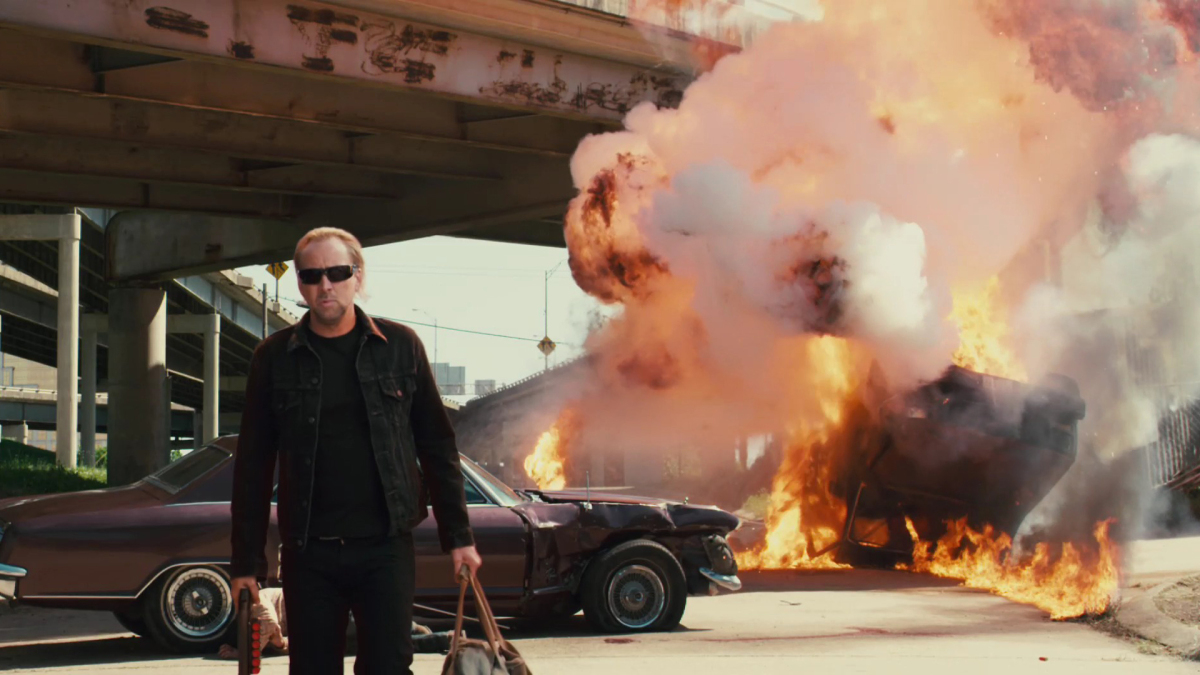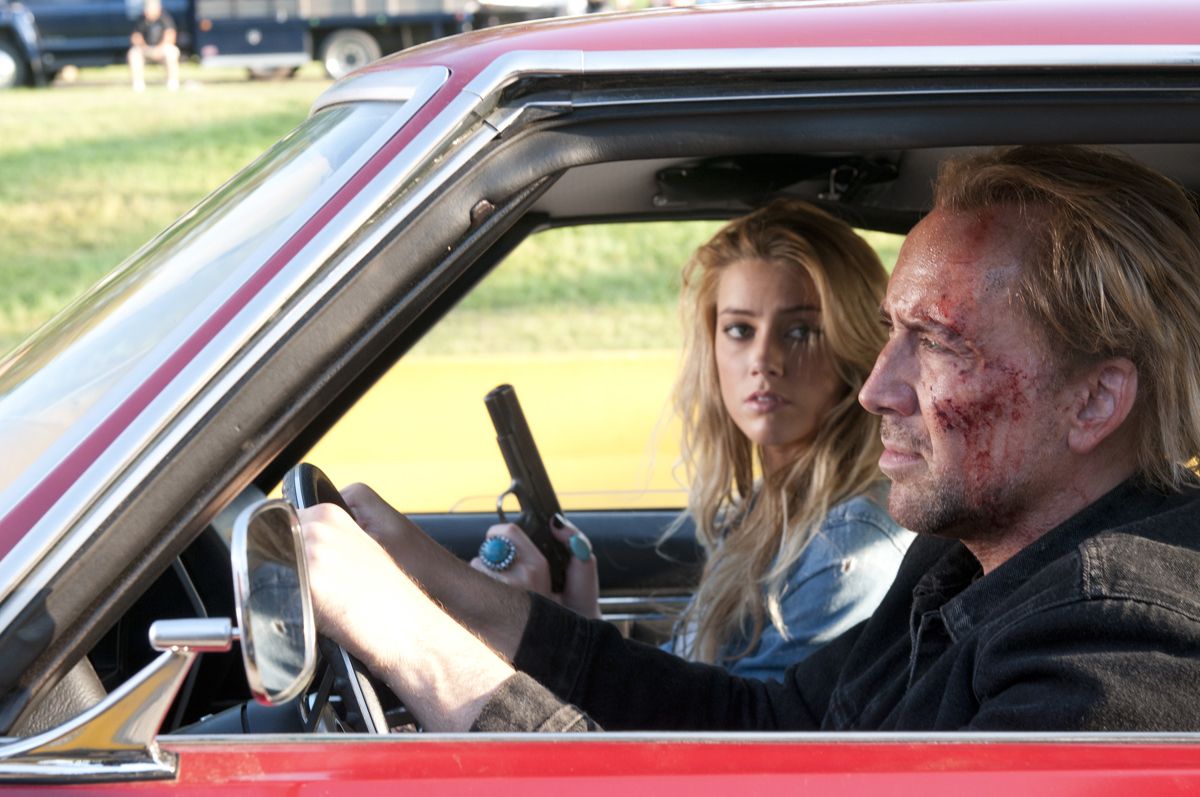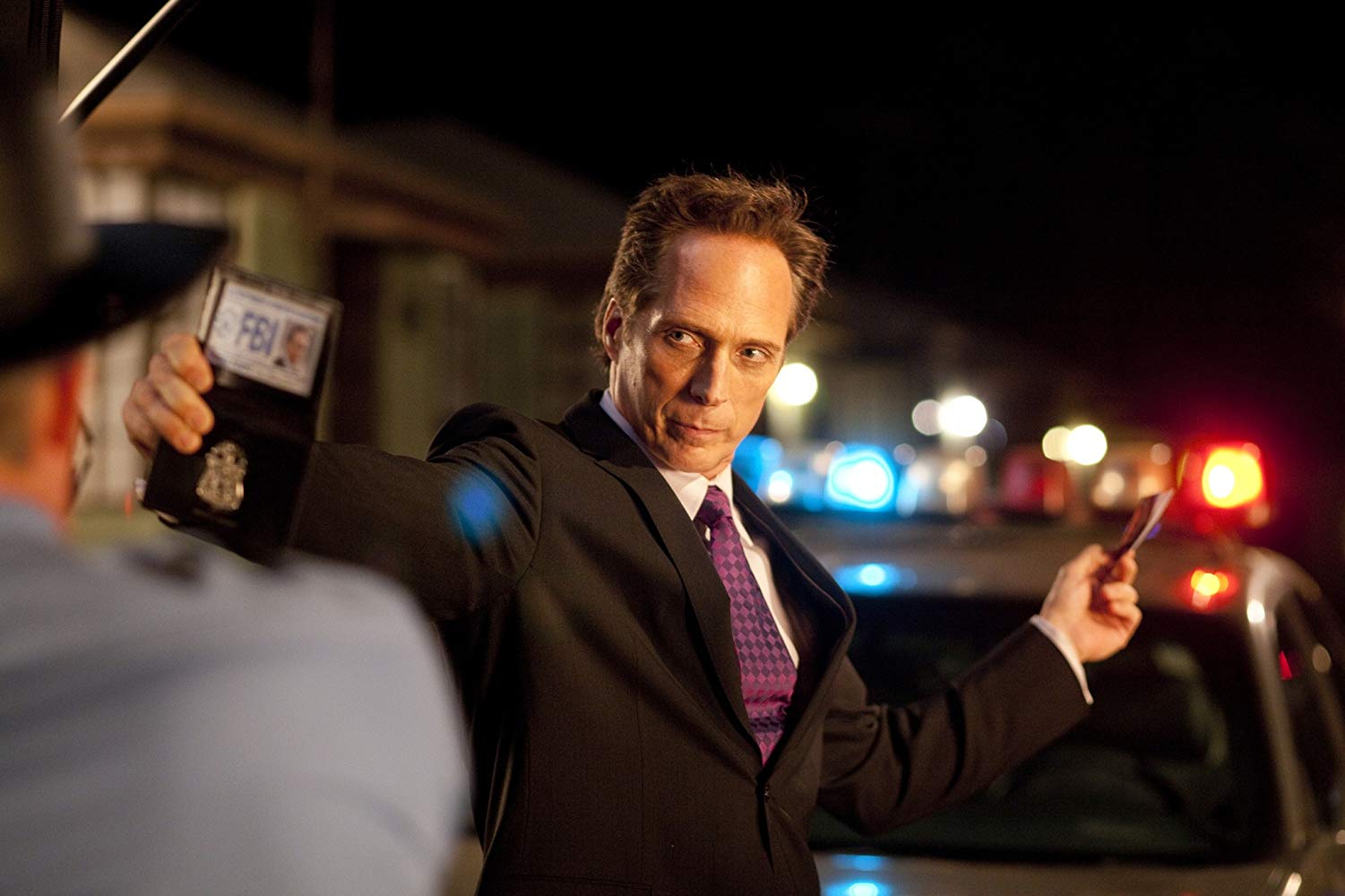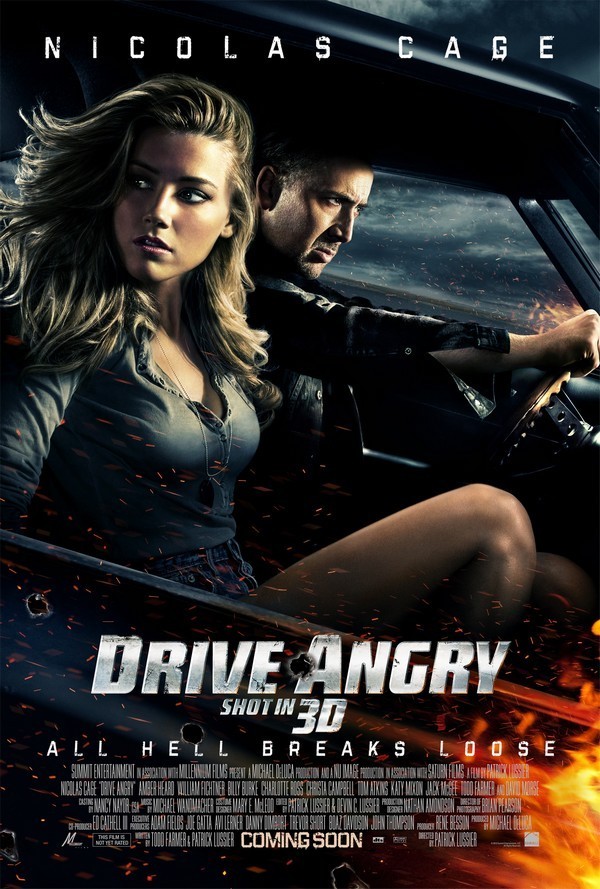aka Drive Angry 3D
USA. 2011.
Crew
Director – Patrick Lussier, Screenplay – Todd Farmer & Patrick Lussier, Producers – Rene Besson, Michael De Luca & Adam Fields, Photography (3D) – Brian Pearson, Music – Michael Wandmacher, Visual Effects Supervisor – Glenn Neufeld, Visual Effects – Worldwide FX (Supervisors – Ajoy Mani & Greg Nelson), Makeup Effects – Two Hours in the Dark, Inc. (Supervisor – Gary J. Tunnicliffe), Production Design – Nathan Amandson. Production Company – Millennium Pictures/Saturn Films/Nu Image.
Cast
Nicolas Cage (John Milton), Amber Heard (Piper), William Fichtner (The Accountant), Billy Burke (Jonah King), David Morse (Webster), Todd Farmer (Frank Remy), Tom Atkins (State Trooper Captain), Charlotte Ross (Candy), Jack McGee (Fat Lou)
Plot
John Milton travels across Oklahoma and Louisiana in pursuit of Jonah King, the leader of a Satanist cult. He hitches a ride with Piper, a waitress who has just quit her job. She gets home to find her fiance Frank in bed with another woman. Milton returns just in time to prevent Frank from beating her up. She and Milton depart, taking Frank’s 1969 Dodge Charger. Pursuing hot on Milton’s tail is the supernaturally empowered figure known as The Accountant. Milton explains to Piper that he is determined to stop Jonah King who killed his daughter and is now preparing to sacrifice a baby that will allow Hell to open up on Earth. Piper gradually becomes aware that Milton has not been in jail as he leads her to believe but has escaped from Hell to stop Jonah King and that The Accountant has been despatched to bring him back.
It was hard to know what to make of Drive Angry before it opened. It seemed a film that had taken the Devil comes to reclaim a soul plot from Angel Heart (1987) or perhaps Highway 61 (1991) and combined it with one of the Fast and the Furious films. The very title Drive Angry (referred to as Drive Angry 3D in most of the publicity although not on the screen) and the emphasis on classic cars renowned for their cool seemed to pitch the film to a certain crowd. The prominent emphasis of the 3D aspect in the title immediately also drew association to director Patrick Lussier’s previous My Bloody Valentine (2009), one of the films that came out just before the current 3D fad. There Lussier played the 3D element in a wilfully trashy way, showing blood, death implements and body parts coming out the screen into our laps.
The trailer for Drive Angry gave the impression that the film was aimed squarely into that same territory with tongue planted cheerfully in cheek. The combination on the credits of Patrick Lussier who has largely shown himself as a genre hack elsewhere; prize bad-actor Nicolas Cage; and production company Nu Image, best known for their low-budget action films, added up to a not-terribly-promising mix.
The Canadian-born Patrick Lussier began in the industry as an editor, cutting almost all of Wes Craven’s films from the 1990s through to the present. Lussier made his directorial debut with The Prophecy 3: The Ascent (2000) and then went onto the Wes Craven presented Dracula 2000 (2000). This was followed by a host of other films, including Dracula II: Ascension (2003), Dracula III: Legacy (2004), White Noise: The Light (2007), the remake of My Bloody Valentine, Trick (2019) and Play Dead (2022). Lussier subsequently went on to co-write the script for Terminator Genisys (2015). Lussier co-writes Drive Angry with Todd Farmer who also wrote the scripts for the likes of Jason X (2001), The Messengers (2007) and My Bloody Valentine. (Farmer can also be seen on screen here in the role of Amber Heard’s redneck fiance).

Watching Drive Angry, what one is reminded of is a 1970s car chase movie – the likes of The Getaway (1973), Charley Varrick (1973), Dirty Mary, Crazy Larry (1974), indeed all of the films that Quentin Tarantino readily namedrops in Death Proof (2007) – most of which gained their greatest popularity with drive-in audiences. Many of these were set in the Southern US states (as Drive Angry is), which apparently has the greatest number of drive-ins in the country, before the Southern car chase movie went mainstream with overtly comedic hits like Smokey and the Bandit (1977) and sequels and tv’s The Dukes of Hazzard (1979-85). Indeed, the Southern car chase film had previously been mashed up with the occult film and pursuit by Satanic cults in Race with the Devil (1975).
The entire film feels less like it has a script than it is designed in comic-book panels replete with onomatopoeic sound effects. The vehicle stunts are absurdly over the top – a hydrogen tanker flips through the air, lightly denting the roof of Nicolas Cage’s oncoming car as it passes over before blowing up a line of cop cars behind; Cage makes his climactic entrance into a quarry by crashing a car through a burning pentagram thirty feet up in the air; or shoots at a driver heading towards him before their vehicle collapses into a previously unseen floor pit two feet in front of him.
The dialogue frequently teeters on the laughable – Nicolas Cage delivers lines like “Hell’s already walking the Earth – tell them I’m coming.” Indeed, this is a film where Nicolas Cage can make the threat to drink beer from villain Billy Burke’s skull – and in the last scene is seen doing precisely that.

In My Bloody Valentine, Patrick Lussier made a virtue of delivering gore and splatter effects in 3D. We get a similar range of 3D gore effects here – Todd Farmer having a baseball bat impaled through his eye socket, the elimination of various cultists with machetes and hoes in the head, bullets seen spinning through the air in slow-motion before hitting people and so on. Lussier and Todd Farmer make a direct appeal to a trashy exploitation element that seems to have vanished from the modern horror film – one of the most well remembered scenes from My Bloody Valentine was a naked woman running around a motel parking lot waving a gun before she is killed and so we get a similar scene here with Amber Heard engaged in a fistfight with a naked Christa Campbell in the forecourt of a trailer park.
The film’s most joyous moment is a scene involving Nicolas Cage having sex with Charlotte Ross in a motel room as various cultists burst in, he swivelling her naked body around without withdrawing from her while holding a gun in one hand and a bottle of Jack Daniels in the other, blowing away cultists right and left in a great deal of slow-motion violence, before one of them jolts Cage with a taser and Charlotte Ross goes into ecstasy beneath him.
This seems precisely the level that Drive Angry is intended on – as an absurd horror/action film that comes with tongue planted entirely in cheek and the white trash element played up to aim the film at the American states where a baseball cap is considered formal wear. As this type of wilfully silly comic-book, Drive Angry proves far more entertaining than anything one expects of it going in.

As with other films like Spawn (1997), End of Days (1999), Constantine (2005), the previous Nicolas Cage film Ghost Rider (2007) and Legion (2010), Drive Angry depicts matters of Heaven and Hell in modern day action movie terms – one where the means of despatch for agents of the hereafter is a supernaturally empowered uzi or shotgun; where envoys from the afterlife prefer to drive about in cool yet very earthly machines such as motorcycles and classic cars; where Hell is no more than a tough prison sentence and the ability to escape can be made with the steely, single-minded determination of an action movie hero on a mission to save the lives of innocents.
Nicolas Cage, who also produces Drive Angry through his Saturn Films production company, is his usual screen persona and passes through the film with the monosyllabic glare of fiercely determined action hero intent that he has perfected. Amber Heard’s role is largely there because the genre that Drive Angry takes place in dictates that the guy go into action with a girl in the passenger seat. For her own part, Heard holds the screen in a fierce kickass performance.
The one appearing to be having the most fun is William Fichtner. Fichtner has come to be typecast in various roles as tightly wound anal-retentive bureaucrats. Here he gets to play his ultimate asshole bureaucrat role and has a ball indifferently despatching people or delivering prognostications on their fates. Billy Burke has a fairly one-dimensional villain role where you would swear he is trying to come off as a younger version of Tommy Lee Jones.
Trailer here


